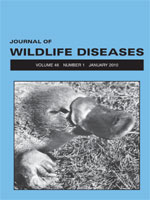The pathogenic potential of deerpox virus was investigated via an experimental study utilizing seven black-tailed deer fawns (Odocoileus hemionus) between June and August of 2007. Successful transmission was achieved via intracutaneous and intravenous routes, and by commingling an uninoculated animal with experimentally infected fawns. One fawn became depressed and reluctant to eat but systemic clinical signs in the other fawns were confined to mild transient pyrexia. Typical multifocal poxviral cutaneous lesions of erythema, papules, pustules, ulceration, and crusting were observed. Two locally extensive ulcerative lesions also developed at inoculation sites. Oral lesions were seen in one commingled fawn, with some palatine epithelial cells containing intracytoplasmic inclusions. Microscopic cutaneous lesions included epithelial cell hyperplasia with hydropic change, intraepithelial pustules, erosions, folliculitis, and dense leukocytic dermal infiltrates. Transmission was confirmed by one or more of virus isolation, polymerase chain reaction or serum neutralization tests. Significant internal lesions were not seen at necropsy.
How to translate text using browser tools
1 January 2010
EXPERIMENTAL DEERPOX INFECTION IN BLACK-TAILED DEER (ODOCOILEUS HEMIONUS COLUMBIANUS)
Rob J. Bildfell,
Kimberly A. Thompson,
Megan Moerdyk-Schauwecker,
Ling Jin,
Peregrine L. Wolff,
Colin M. Gillin
ACCESS THE FULL ARTICLE

Journal of Wildlife Diseases
Vol. 46 • No. 1
January 2010
Vol. 46 • No. 1
January 2010
black-tailed deer
Cervidpoxvirus
deerpox
dermatitis
Odocoileus hemionus
pox virus
raw neck syndrome




